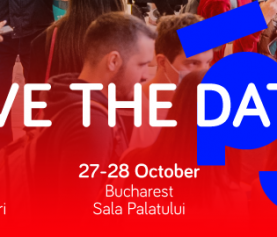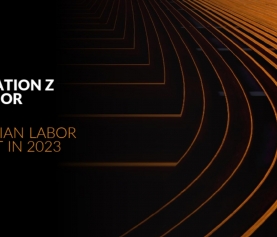May 23rd, 2018
Are you keeping on hearing those trendy marketing buzzwords, but don’t really know what they mean for your employer branding strategy? Misunderstanding can prevent you from using them to their full potential. That’s why we created a list which will give you a solid knowledge on how to make most of them.
So, let’s break some of the definitions of the most popular buzzwords of 2018.
Candidate experience
It’s how job candidates perceive your hiring process and the perception they have towards you as an employer based on all the interactions with your company. Candidate experience is built on emotions of a candidate therefore it’s hard to control it. However, you can learn to shape it into the positive one with strong employer branding.
Candidate journey
It’s a journey in which job seekers go throughout following stages: Awareness, Consideration, Interest, Application, Selection and Hire. Note that beginning of the candidate journey is especially important for passive candidates. However, on each stage you are meant to engage and nurture all the talents in order to convert a lead into a hire.
Lead Nurturing
Lead Nurturing is the process of developing quality relationships with your audience on every stage of the recruitment process and maintaining it throughout the whole candidate journey. The key is to come up with an individual lead scoring system which will focus on fulfilling and answering the needs of your audience.
Data Driven Recruiting
It’s a recruiting strategy in which planning and decision making is based on data acquired through HR technology such as Applicants Tracking Systems and Recruitment Marketing Platforms. Using this methodology will help you make better decisions and improve the quality of hire.
Inbound Recruiting
This methodology uses a combination of employer branding and digital marketing to attract, engage and convert your audience throughout forming a strong relationship with them. With inbound recruiting your target groups of passive and active job seekers no matter their position in the recruiting funnel.
Brand Ambassadors
Those are representative and fully committed employees who have abilities and passion to vouch for your brand in front of potential candidates. By sharing their personal experience within the company, they are able to gain trust of your audience and make them want to be a part of the team.
Mobile revolution
Smartphones rule our lives and the way we get things done. That means you need to be prepared for mobile revolution and make sure all the job posts, application forms and career portals are mobile optimised in order to keep up with the preferences of your audience.
Gig Economy
It’s a work environment in which hiring employees on temporary positions is a common way to get the job done. We can notice more and more people wrap their lives around short-term engagements. It means you will most likely save up some money but you will lose the chance to build committed and devoted team.
Marketing Automation
Marketing Automation makes your job easier with the help of new technologies. It involves using specific software that allows you to automate simple marketing tasks, which saves time and speed up the workflow.
Marketing Optimisation
The process of optimising leads to higher search results and driving more traffic to your site. Most of all optimisation is basically maximizing what you are doing to get the best results with the least effort.
Virtual Reality
Virtual Reality, as the name suggests, is the experience of the word that doesn’t actually exist, but you are able to face it thanks to technology. Integrating VR with your recruitment process has a great potential for engaging your candidates and making your candidate experience stand out. Here is a cool example of VR tour:
Big Data
In short, all the data – whether or not categorized – present in your servers is collectively called BIG DATA. The idea behind Big Data is that every internet user leaves a digital trace behind. Therefore, it can be collected, analysed and use in order to better understand and precisely target your desired audience.
Analytics
You can think of analytics as simply the process of analysing any kind of data. In recruitment, they are the key to monitor and adjust the approach in order to improve your overall performance.
Omni-channels
Omnichannel approach means creating the seamless online presence that reaches the candidate wherever they are searching or browsing and targeting him with a coherent message across all the platforms.
Brand consistency
Brand consistency is one of the most important rules of branding. Preserving brand consistency means staying close to the core brand strategy, values and foundation. This means the brand’s voice is kept in the same tone, the logo is always used in a similar way and typography and colour are consistent across all the media.
Reach
How many people saw my post? Reach is the number of people that will likely be exposed to your online content. Estimating reach is tricky because when you run an ad multiple times, the same person may see the ad more than once but you only want to count them once in Reach. There are different kinds of reach metrics on each social network. For example, Facebook reach falls into three different categories: organic, paid and viral.
Impression
How many times did my post get displayed? Impressions are the total number of exposures to your online advertisement. That means one person can receive multiple exposures over time. If one person was exposed to an advertisement four times, this would count as four impressions. The metric is available for organic and paid ads. Also, a viewer doesn’t have to engage with the post in order for it to count as an impression.
Engagement
Engagement is the most important metric on social media campaign. It measures the number of interactions people have with your content – likes, comments, shares etc.
Conversion
Conversion happens when a candidate takes an action you want him to take. It could be any kind of interaction with your brand – from downloading an eBook to filling up an application form for a job.
Click Through Rate – CTR
Click-through rate is the percentage of people who click on your ad after seeing it. Your CTR can be set when doing simple calculation – dividing total ad clicks by total ad impressions. You can improve your score by providing content that your audience is truly interested in.
Key Performance Indicator – KPI
KPI provides a way to measure how effectively your company is performing in relation to its key goals and objectives. KPI are instruments to navigate and evaluate your progress in reaching the target. In most companies, KPI is automatically tracked via business analytics and reporting tools that collect relevant data from operational systems and create reports on the performance.
PPC – Pay Per Click
Pay Per Click refers to the online advertising model in which you pay to the host every time your ad is clicked by the web user. What’s important, you pay only when your ad is clicked.
SEO – Search Engine Optimization
SEO is the process of getting traffic from the free/organic/natural search results on search engines. Search engines use algorithms that are designed to help people find what they are looking for. So, make yourself visible by paying attention to words, titles, links you use and create content that people will most likely engage with.
Google Display Network – GDN
This ad model puts your brand in front of a large group of internet users, taking the form of static or rotating image banners or videos. They can appear based on: placement targeting (precise website the ad will appear at), contextual (based on chosen keywords) and remarketing (involving cookies). You will be charged based on how many times your ad was seen.
Call to Action – CTA
Call To Action is a part of marketing strategy based on strong statement designed to motivate your audience to follow up on the activity you want them to complete (Apply now). CTA are essential in leading your audience where you want them to go.
CRM – Customer Relation Management
CRM is a method for managing and improving relationships with current and potential future job candidates. CRM uses technology to organize the communication process with the candidates in order to encourage their engagement and improve their overall candidate experience.
Evergreen content
Evergreen content means timeless content that provides high-quality, value for content consumers. It’s not only articles, but also guides, eBooks, tutorials and case studies which are good examples of timeless content.
Storytelling
Storytelling has the power to engage your audience on the emotional level through entertainment. By turning your company message into a narrative, you make it more attractive and easy to remember.
Long- and Short-Tail Keywords
Short-tail keywords are short, general terms covering broad areas of a subject, resulting with high search volume, and high competition. On the contrary, long-tail keywords (3-5 words) are long terms which are better precising the subject of searches – meaning they are less popular but more targeted at specific needs.
Open Rate
The open rate relates to email marketing and it measures the percentage of people who actually opened and read your email. Notice that open rates can be misleading measure of your company success – just because somebody opened your e-mail doesn’t mean he liked or engaged with the content.
Custom Audience
A custom audience its an option on Facebook which enables you to create personalized ad and direct it to the right audience, based on the data you’ve collected in the past.
Lookalike audience
Facebook’s lookalike audiences are audiences created with Facebook’s algorithm to find unexpected commodities. This group will consist of people who are not your audience, but share traits with them. That means algorithm, it’s tracking, hidden similarities in people who at the end might be interested in your offer.
Organic Facebook reach
Organic reach is the number of people who see your content without you paying for it. What’s worth to keeping in mind, organic Facebook campaigns tend to engage more people than paid ads. The more organic reach you have, the better your lead generation and conversion funnels will function.
Bounce rate
Bounce rate is the percentage of people who come on your website and leave it without taking any further action. So, basically, it’s a tool designed to let you know if you’re attracting the right people and you’re giving them what they’re looking for.
Above the fold
This buzzword relates precisely to a top section of your website, so basically, it’s what the visitor sees before scrolling down the page. Keeping the main intent of a page above the fold means making the information accessible and easy to find for the website users.
User Interface Design – UI
The main purpose of User Interface is to provide a system that answer the needs of its users. In short, it’s all the visual solutions – like layout or interface the audience interact with. In order to be effective, it should be displayed in consistent, intuitive and clear way.
User Experience Design – UX
If UI is form, you can think of UX as a technical function. UX focuses on improving the customer satisfaction through usability and designing systems that provide error free experience for users.
Now when you know what stands behind all those trendy buzzwords you will be able to use them efficiently in your employer branding strategy. Good luck!








